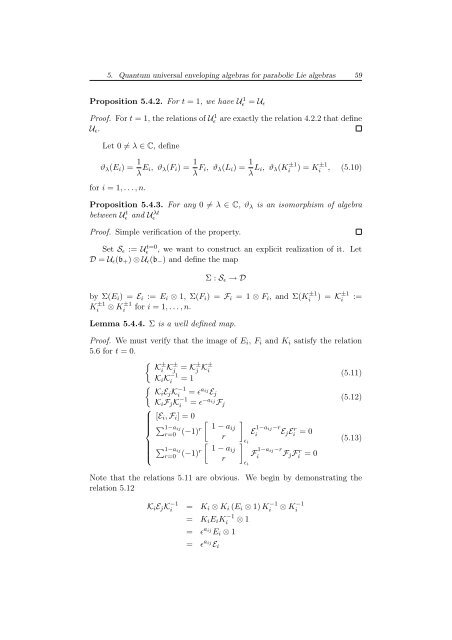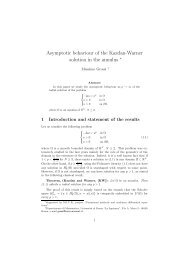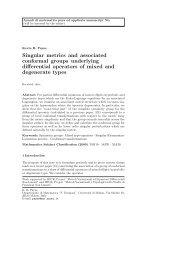Degree of Parabolic Quantum Groups - Dipartimento di Matematica ...
Degree of Parabolic Quantum Groups - Dipartimento di Matematica ...
Degree of Parabolic Quantum Groups - Dipartimento di Matematica ...
You also want an ePaper? Increase the reach of your titles
YUMPU automatically turns print PDFs into web optimized ePapers that Google loves.
5. <strong>Quantum</strong> universal enveloping algebras for parabolic Lie algebras 59<br />
Proposition 5.4.2. For t = 1, we have U 1 ǫ = Uǫ<br />
Pro<strong>of</strong>. For t = 1, the relations <strong>of</strong> U 1 ǫ are exactly the relation 4.2.2 that define<br />
Uǫ.<br />
Let 0 = λ ∈ C, define<br />
ϑλ(Ei) = 1<br />
λ Ei, ϑλ(Fi) = 1<br />
λ Fi, ϑλ(Li) = 1<br />
λ Li, ϑλ(K ±1<br />
i ) = K ±1<br />
i , (5.10)<br />
for i = 1, . . .,n.<br />
Proposition 5.4.3. For any 0 = λ ∈ C, ϑλ is an isomorphism <strong>of</strong> algebra<br />
between U t ǫ and U λt<br />
ǫ<br />
Pro<strong>of</strong>. Simple verification <strong>of</strong> the property.<br />
Set Sǫ := U t=0<br />
ǫ , we want to construct an explicit realization <strong>of</strong> it. Let<br />
D = Uǫ(b+) ⊗ Uǫ(b−) and define the map<br />
Σ : Sǫ → D<br />
by Σ(Ei) = Ei := Ei ⊗ 1, Σ(Fi) = Fi = 1 ⊗ Fi, and Σ(K ±1<br />
i ) = K ±1<br />
K ±1<br />
i ⊗ K±1<br />
i for i = 1, . . .,n.<br />
Lemma 5.4.4. Σ is a well defined map.<br />
i :=<br />
Pro<strong>of</strong>. We must verify that the image <strong>of</strong> Ei, Fi and Ki satisfy the relation<br />
5.6 for t = 0.<br />
±<br />
K i K ± j = K± j K± i<br />
(5.11)<br />
KiK −1<br />
= 1<br />
i<br />
<br />
KiEjK −1<br />
i = ǫaijEj KiFjK −1<br />
i = ǫ−aijFj ⎧<br />
⎪⎨<br />
⎪⎩<br />
[Ei, Fi] = 0<br />
1−aij r=0 (−1)r<br />
<br />
1 − aij<br />
1−aij<br />
r=0 (−1)r<br />
<br />
r<br />
<br />
1 − aij<br />
r<br />
ǫi<br />
ǫi<br />
E 1−aij−r<br />
i EjE r i<br />
F 1−aij−r<br />
i FjF r i<br />
= 0<br />
= 0<br />
(5.12)<br />
(5.13)<br />
Note that the relations 5.11 are obvious. We begin by demonstrating the<br />
relation 5.12<br />
KiEjK −1<br />
i<br />
= Ki ⊗ Ki (Ei ⊗ 1) K −1<br />
i<br />
= KiEiK −1<br />
i<br />
= ǫ aij Ei ⊗ 1<br />
= ǫ aij Ei<br />
⊗ 1<br />
⊗ K−1<br />
i








